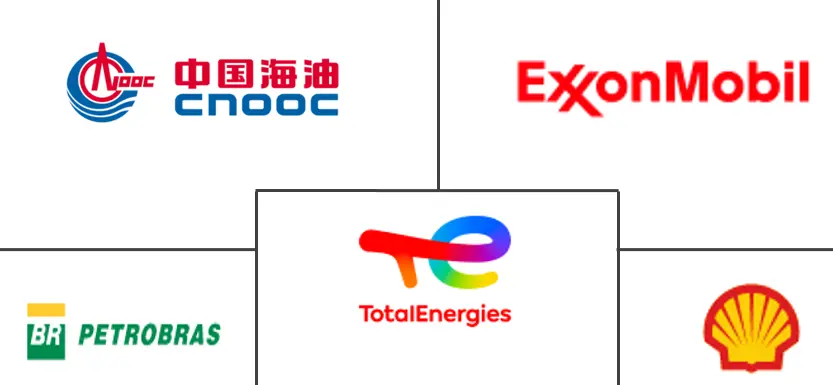FPSO Market Size and Share
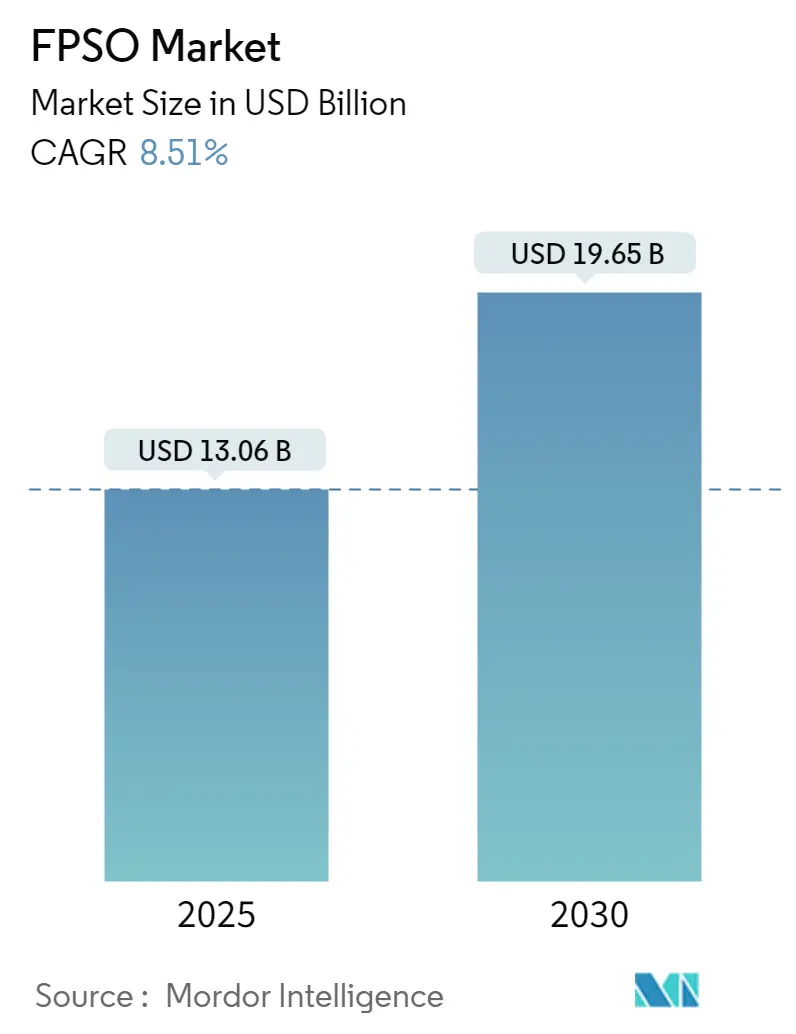
FPSO Market Analysis by Mordor Intelligence
The FPSO Market size is estimated at USD 13.06 billion in 2025, and is expected to reach USD 19.65 billion by 2030, at a CAGR of 8.51% during the forecast period (2025-2030).
- In the medium term, the increasing exploration and production activities in deep and ultradeep water depths are expected to drive the FPSO market during the forecast period.
- On the other hand, the high upfront cost is expected to hinder the market's growth during the forecast period.
- Nevertheless, the technological advancements and innovation in FPSO systems are expected to create huge opportunities for the FPSO market.
- South America is expected to be a dominant region for the FPSO market due to increasing offshore activities in the region.
Global FPSO Market Trends and Insights
The Contractor-owned Segment is Expected to Dominate the Market
- There are three primary methods for procuring FPSOs: new build, conversion of an existing vessel, and redeployment of an existing unit. Among these options, redeployment poses several challenges due to the highly customized nature of the FPSO for a specific field. As a result, operators have predominantly favored the new build and conversion approaches, often relying on third-party contractors with specialized expertise for these services over the past two decades.
- Contractor-owned FPSOs offer cost advantages over operator-owned FPSOs or fixed platforms. Contractors specializing in designing, constructing, and operating FPSOs can achieve economies of scale and optimize their fleet utilization, reducing operator costs. This makes contractor-owned FPSOs an attractive option for operators seeking cost-effective solutions.
- Contractor-owned FPSOs are typically available for lease, providing operators greater flexibility in field development. Leasing allows operators to access and deploy FPSOs with minimal upfront capital investments, benefiting smaller operators or projects with uncertain production profiles.
- With increasing offshore activities, the cost of exploration and production activities is increasing, and FPSO-related activities are being outsourced to contractors. This allows operators to allocate their resources and attention to areas where they can create the most value, leaving the FPSO operations to specialized contractors.
- For instance, according to Baker Hughes Rig Count, at the end of 2023, there were around 246 offshore rigs, which witnessed about 6.4% compared to the previous year, signifying an increase in offshore exploration and production activities, consequently driving the demand for FPSOs.
- In May 2023, MODEC, a Japanese FPSO supplier, secured a contract from Equinor to supply an FPSO vessel for the BM-C-33 block in the Campos Basin offshore Brazil. In addition to delivering the FPSO, which is expected to be completed by 2027, MODEC will provide Equinor with operations and maintenance services for the first year of the FPSO's oil production. Subsequently, Equinor plans to take over the operational responsibilities of the FPSO.
- There are several untapped offshore reserves globally that have not been discovered yet or are in the process of exploration. As oil and gas companies are focusing on discovering these untapped oil and gas reserves in the future, the demand for FPSO is expected to increase.
- With increasing demand for FPSO and its advantages over other types of FPSO, the Contractor-owned FPSO is expected to dominate the market during the forecast period.
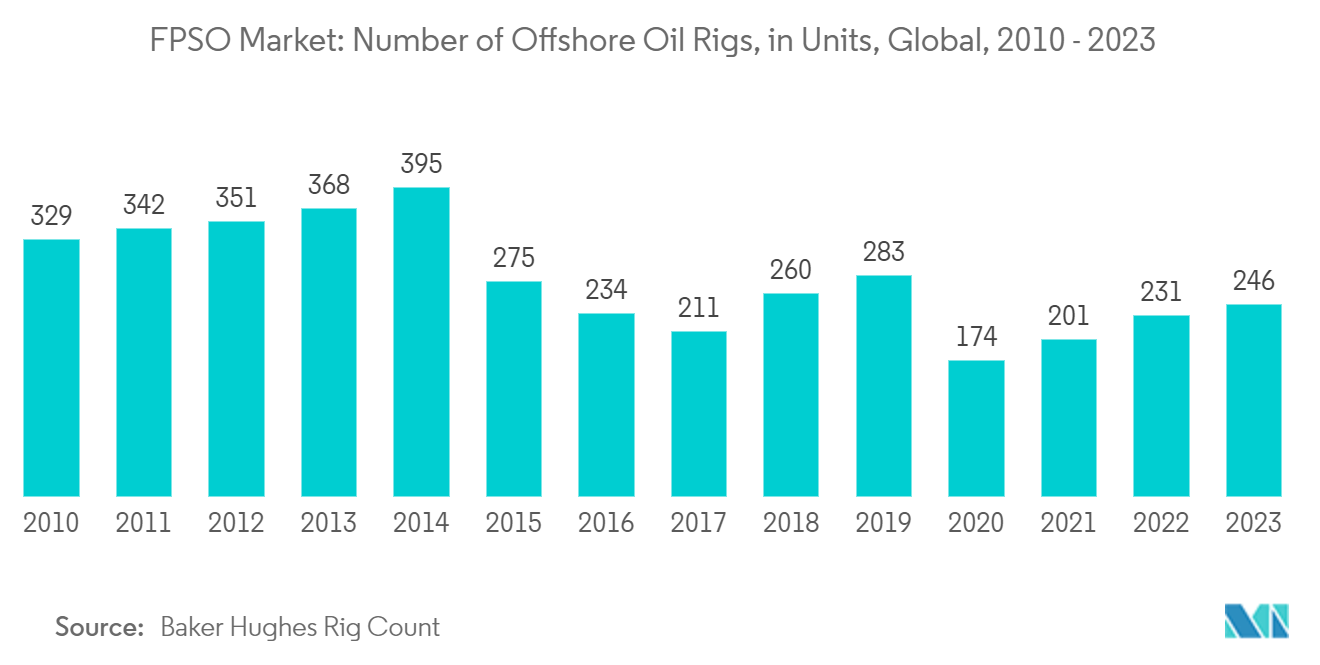
South America is Expected to Dominate the Market
- South America is anticipated to exert the highest influence on the global FPSO market. Particularly, Brazil and Guyana have emerged as key players in this market, experiencing a significant surge in demand for FPSOs in recent years.
- South America has significant offshore oil and gas reserves, particularly in Brazil and Guyana. These reserves are located in deepwater and ultra-deepwater areas, requiring FPSOs for efficient production, storage, and offloading. The potential for large-scale discoveries and production in these regions drives the demand for FPSOs.
- For instance, in January 2024, Offshore Frontier Solution Pte Ltd awarded a contract for an electrical system and associated digital solutions on an ExxonMobil floating production storage and offloading (FPSO) vessel for the South American Uaru oil field. The unit will perform operations approximately 200 kilometers off the coast of Guyana.
- Moreover, South America has extensive pre-salt reserves, especially in Brazil's Santos and Campos Basins. These reserves are located beneath thick layers of salt, presenting technical challenges for exploration and production. FPSOs are well-suited for these challenging environments, as they can safely operate in deepwater and handle the complex processing requirements of pre-salt fields. Thus, in the future, with the upcoming deep and ultra-deep oil and gas projects' exploration and production in the region, demand for the FPSO is expected to grow.
- Therefore, as per the above points, South America is expected to dominate the FPSO market during the forecast period.
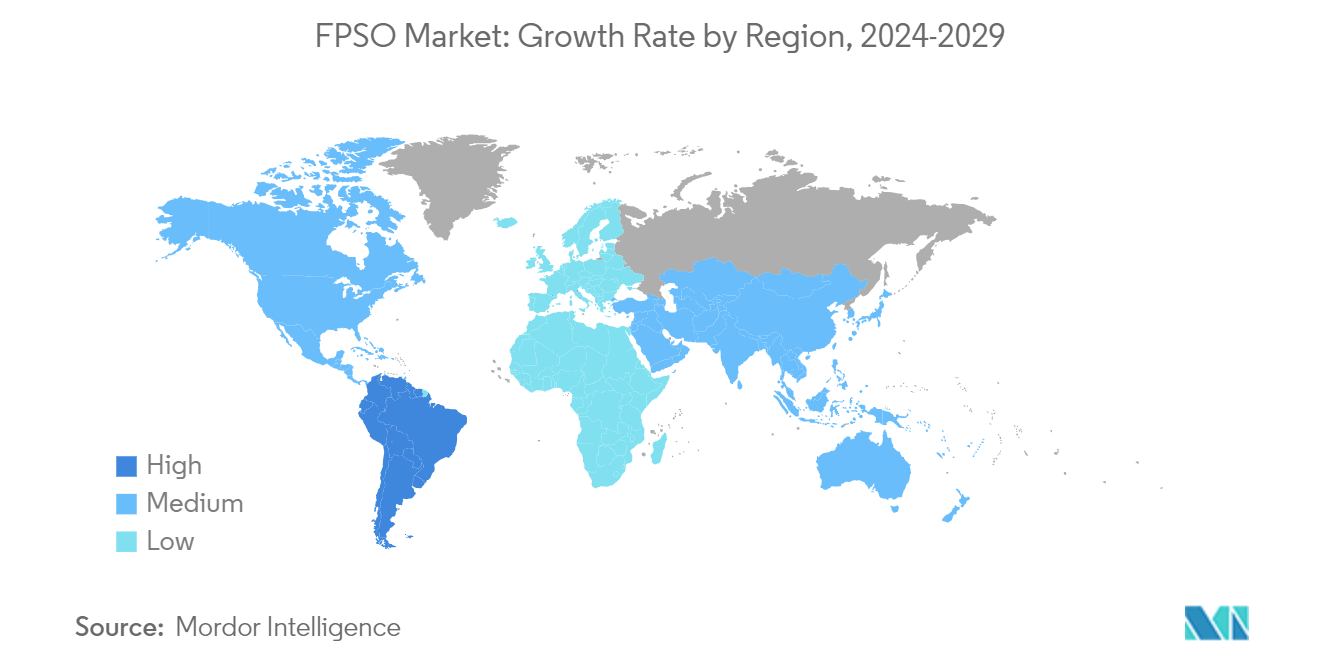
Competitive Landscape
The FPSO market is moderately consolidated. Some of the major players in the market are Petroleo Brasileiro SA (Petrobras), CNOOC Ltd, TotalEnergies SE, Exxon Mobil Corp., and Shell PLC.
FPSO Industry Leaders
-
CNOOC Ltd.
-
Petroleo Brasileiro SA (Petrobras)
-
Shell Plc.
-
Exxon Mobil Corp
-
TotalEnergies SE
- *Disclaimer: Major Players sorted in no particular order
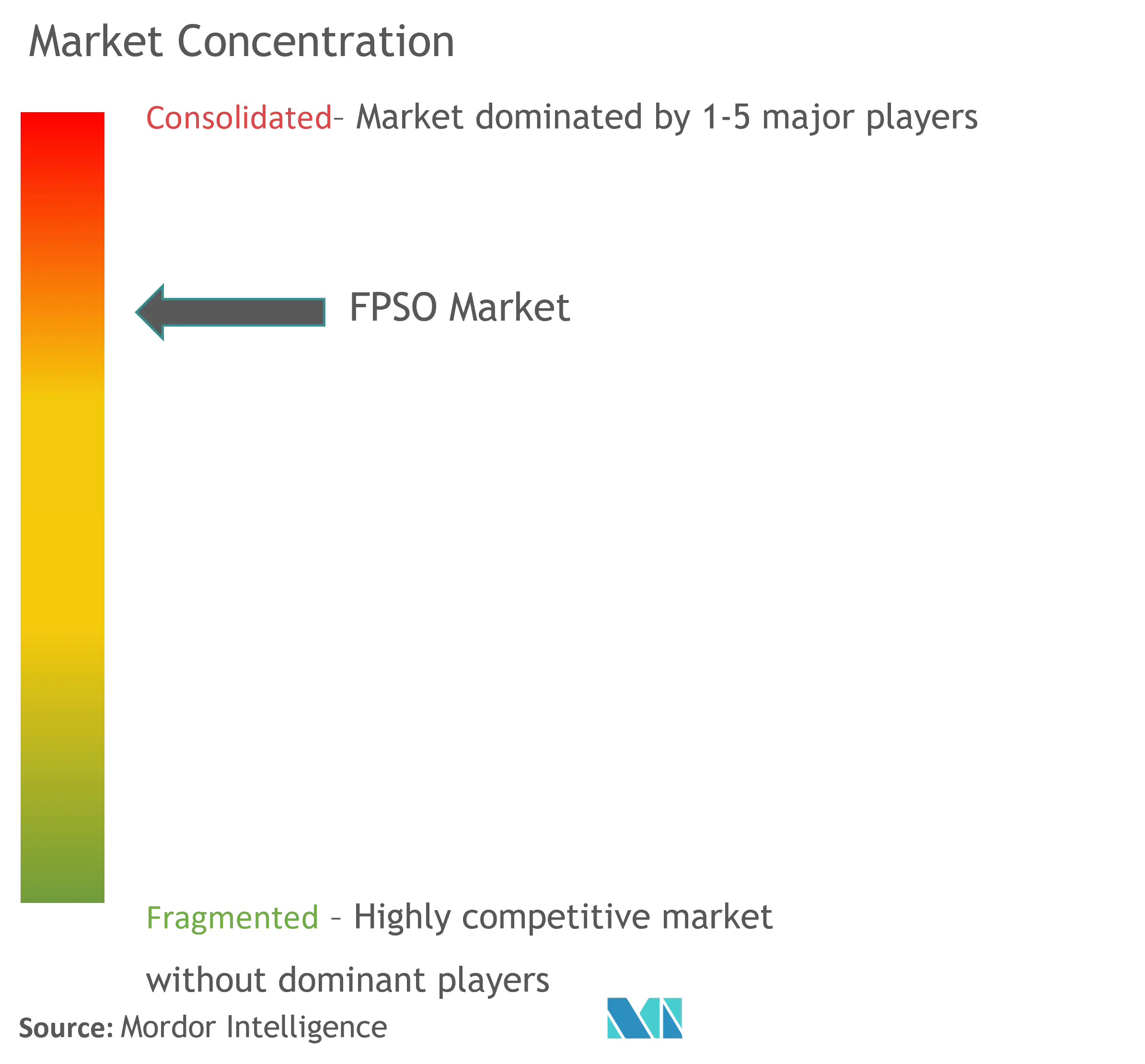
Recent Industry Developments
- May 2023: SBM Offshore and Esso Exploration & Production Guyana entered a 10-year Operations and Maintenance Enabling Agreement. The agreement entails SBM Offshore being responsible for the operations and maintenance of four FPSOs: Liza Destiny, Liza Unity, Prosperity, and ONE GUYANA.
- April 2023: Following a major upgrade to enable gas production, Shell resumed operations at the Pierce field in the United Kingdom Central North Sea. The Haewene Brim floating production, storage, and offloading vessel (FPSO), utilized for hydrocarbon production at the Pierce field, underwent significant modifications. A new subsea gas export line was installed, connecting to the SEGAL pipeline system, which transports gas to the St Fergus facility north of Aberdeen. This development allows for the extraction of gas from the Pierce field, which had previously been focused solely on oil production.
- April 2023: KBR, headquartered in Houston, officially announced the unexpected acquisition of an engineering contract for Equinor's Bay du Nord project, valued at USD 9.4 billion and located in the offshore eastern region of Canada. The awarded contract encompasses the possibility of providing detailed design and procurement management services until the completion of the FPSO unit.
Global FPSO Market Report Scope
FPSO stands for floating production, storage, and offloading. It is a type of offshore vessel used in the oil and gas industry for producing, processing, storing, and offloading hydrocarbons. FPSOs are typically deployed in offshore fields where it is not feasible or economically viable to build fixed production platforms.
The FPSO market is segmented by construction, water depth, and geography. By construction, the market is segmented into contractor-owned and operator-owned. By water depth, the market is segmented into shallow water, deep water, and ultra-deep water. By geography, the market is segmented into North America, Europe, Asia-Pacific, South America, and Middle East and Africa. The report offers the market sizes and forecasts in revenue (USD) for all the above segments.
| Operator-owned |
| Contractor-owned |
| Shallow Water |
| Deep Water |
| Ultra-deep Water |
| North America | United States |
| Canada | |
| Mexico | |
| Rest of North America | |
| Europe | Norway |
| United Kingdom | |
| Russia | |
| Netherland | |
| France | |
| Italy | |
| NORDIC | |
| Germany | |
| Spain | |
| Rest of Europe | |
| Asia-Pacific | China |
| India | |
| Australia | |
| Indonesia | |
| Malaysia | |
| Thailand | |
| Japan | |
| Vietnam | |
| Rest of Asia-Pacific | |
| South America | Brazil |
| Argentina | |
| Venezuela | |
| Colombia | |
| Rest of South America | |
| Middle East and Africa | Saudi Arabia |
| United Arab Emirates | |
| Nigeria | |
| Algeria | |
| Qatar | |
| South Africa | |
| Egypt | |
| Rest of Middle East and Africa |
| Ownership | Operator-owned | |
| Contractor-owned | ||
| Water Depth | Shallow Water | |
| Deep Water | ||
| Ultra-deep Water | ||
| Geography Regional Market Analysis {Market Size and Demand Forecast till 2028 (for regions only)} | North America | United States |
| Canada | ||
| Mexico | ||
| Rest of North America | ||
| Europe | Norway | |
| United Kingdom | ||
| Russia | ||
| Netherland | ||
| France | ||
| Italy | ||
| NORDIC | ||
| Germany | ||
| Spain | ||
| Rest of Europe | ||
| Asia-Pacific | China | |
| India | ||
| Australia | ||
| Indonesia | ||
| Malaysia | ||
| Thailand | ||
| Japan | ||
| Vietnam | ||
| Rest of Asia-Pacific | ||
| South America | Brazil | |
| Argentina | ||
| Venezuela | ||
| Colombia | ||
| Rest of South America | ||
| Middle East and Africa | Saudi Arabia | |
| United Arab Emirates | ||
| Nigeria | ||
| Algeria | ||
| Qatar | ||
| South Africa | ||
| Egypt | ||
| Rest of Middle East and Africa | ||
Key Questions Answered in the Report
How big is the FPSO Market?
The FPSO Market size is expected to reach USD 13.06 billion in 2025 and grow at a CAGR of 8.51% to reach USD 19.65 billion by 2030.
What is the current FPSO Market size?
In 2025, the FPSO Market size is expected to reach USD 13.06 billion.
Who are the key players in FPSO Market?
CNOOC Ltd., Petroleo Brasileiro SA (Petrobras), Shell Plc., Exxon Mobil Corp and TotalEnergies SE are the major companies operating in the FPSO Market.
Which is the fastest growing region in FPSO Market?
South America is estimated to grow at the highest CAGR over the forecast period (2025-2030).
Which region has the biggest share in FPSO Market?
In 2025, the South America accounts for the largest market share in FPSO Market.
What years does this FPSO Market cover, and what was the market size in 2024?
In 2024, the FPSO Market size was estimated at USD 11.95 billion. The report covers the FPSO Market historical market size for years: 2019, 2020, 2021, 2022, 2023 and 2024. The report also forecasts the FPSO Market size for years: 2025, 2026, 2027, 2028, 2029 and 2030.
Page last updated on:
FPSO Market Report
The global FPSO market is poised for significant growth, driven by increasing offshore oil and gas exploration and production activities, particularly in deepwater and ultra-deepwater regions. The floating production systems market is segmented by storage capacity, water depth, construction type, hull type, and ownership. FPSO units with varying storage capacities cater to different operational needs, with the 1-2 MMBBLs segment expected to see considerable growth due to new vessel contracts and bulk reserve discoveries. Deepwater and ultra-deepwater segments are set to dominate, propelled by continuous discoveries of new reserves. The market also sees a division between new build and converted FPSOs, with new builds offering higher construction costs but greater design flexibility, while conversions provide cost-effective solutions. Double hull designs are favored for their safety and operational advantages. The market's expansion is further supported by long-term contracts and collaborative efforts among FPSO companies to develop high-capacity fields, addressing the rising global energy demand. Statistics for the FPSO market share, size, and revenue growth rate are provided by Mordor Intelligence™ Industry Reports. FPSO analysis includes a market forecast outlook and historical overview. Get a sample of this industry analysis as a free report PDF download.
